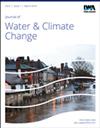Hydroclimatic projection: statistical learning and downscaling model for rainfall and runoff forecasting
IF 2.7
4区 环境科学与生态学
Q2 WATER RESOURCES
引用次数: 0
Abstract
The study is carried out to investigate the surface runoff depth with changing precipitation due to climate change in the study area where sandy loam and loamy soil are dominant. In this study, future rainfall is projected by a statistical downscaling model (SDSM) using a set of predictors derived from a Coupled Model Intercomparison Project Phase 6 (CMIP6) global climate model (GCM) [the Norwegian Earth System Model (NorESM)] with updated scenarios SSP 4.5 and SSP 8.5. Daily rainfall values for the observed period (1981 to 2014) are validated using statistical learning and evaluated with matrices, namely, root mean square error (RMSE), coefficient of correlation, and Nash–Sutcliffe efficiency (NSE), which are found to be valid for further predictions. Rainfall projections show a decrease in rainfall trend by 50% from 2030 to 2040 for scenario SSP 4.5 and an increase of 7% from 2040 to 2050. Predicted rainfall for scenario SSP 8.5 shows a similar trend of decreasing rainfall by 24% for the period 2030–2040 and an increase by 19% in the period 2040–2050. Furthermore, these rainfall values are spatially modelled in a geographic information system (GIS) and rainfall maps are obtained. The obtained rainfall map, land-use map, and soil map are overlaid to compute curve numbers and runoff depths. A similar trend of decrease in runoff is observed for the period 2030–2050. The overall trend of climate change shows a water-stressed scenario.水文气候预测:用于降雨和径流预报的统计学习和降尺度模型
这项研究的目的是调查在以沙壤土和壤土为主的研究地区,随着气候变化引起的降水量变化,地表径流深度也会发生变化。在这项研究中,使用统计降尺度模型(SDSM)对未来降雨量进行了预测,该模型使用了一组从耦合模式相互比较项目第6阶段(CMIP6)全球气候模式(GCM)[挪威地球系统模式(NorESM)]中提取的预测因子,并采用了最新的SSP 4.5和SSP 8.5情景。观测期间(1981 年至 2014 年)的日降雨量值通过统计学习进行了验证,并使用均方根误差(RMSE)、相关系数和纳什-苏特克利夫效率(NSE)等矩阵进行了评估,结果表明这些矩阵对进一步预测有效。降雨预测显示,在 SSP 4.5 情景下,从 2030 年到 2040 年,降雨趋势减少了 50%,从 2040 年到 2050 年,降雨趋势增加了 7%。情景 SSP 8.5 的降雨预测显示了类似的趋势,即 2030-2040 年降雨量减少 24%,2040-2050 年增加 19%。此外,还在地理信息系统(GIS)中对这些降雨值进行了空间建模,并获得了降雨地图。将获得的降雨图、土地利用图和土壤图进行叠加,计算出曲线数和径流深度。在 2030-2050 年期间,也观察到了类似的径流减少趋势。气候变化的总体趋势显示出水资源紧张的局面。
本文章由计算机程序翻译,如有差异,请以英文原文为准。
求助全文
约1分钟内获得全文
求助全文
来源期刊

Journal of Water and Climate Change
WATER RESOURCES-
CiteScore
4.80
自引率
10.70%
发文量
168
审稿时长
>12 weeks
期刊介绍:
Journal of Water and Climate Change publishes refereed research and practitioner papers on all aspects of water science, technology, management and innovation in response to climate change, with emphasis on reduction of energy usage.
 求助内容:
求助内容: 应助结果提醒方式:
应助结果提醒方式:


